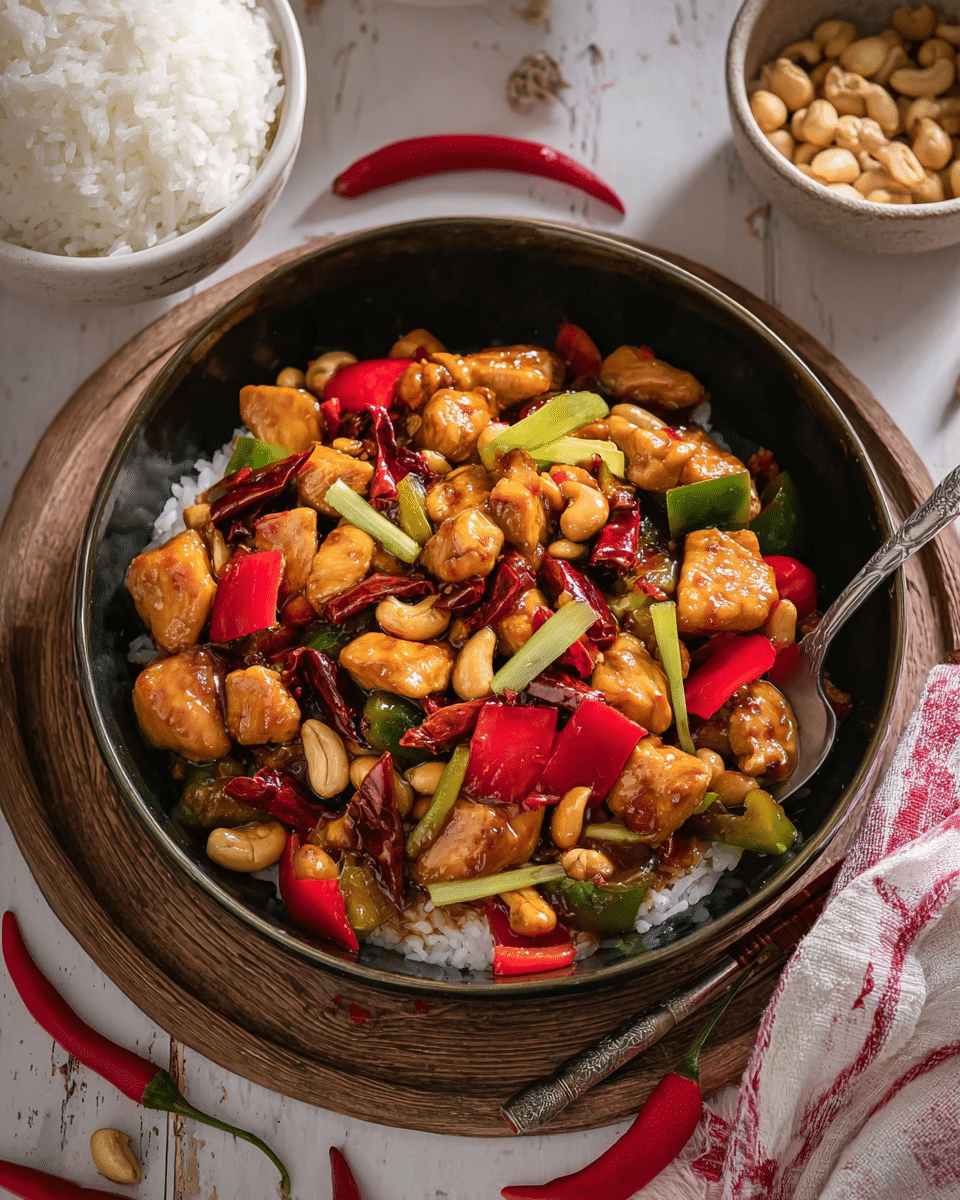Kung Pao Chicken is a perfect balance of heat, savory notes, and nutty crunch. The diced chicken absorbs the bold Szechuan sauce while the peanuts add an irresistible texture that complements the stir-fried vegetables. This dish is quick to prepare, making it ideal for weeknight dinners, yet impressive enough for entertaining. The combination of colors, aromas, and flavors delivers an authentic Chinese culinary experience in the comfort of your home. Pair it with steamed rice or noodles to complete the meal.
Full recipe:
Ingredients:
-
1 lb (450g) boneless, skinless chicken breasts, diced
-
2 tablespoons soy sauce
-
1 tablespoon rice wine or dry sherry
-
2 teaspoons cornstarch
-
3 tablespoons vegetable oil
-
8-10 dried red chilies
-
3 cloves garlic, minced
-
1 tablespoon ginger, minced
-
1/2 cup roasted peanuts
-
1/2 cup diced bell peppers
-
3 green onions, chopped
Sauce:
-
2 tablespoons soy sauce
-
1 tablespoon hoisin sauce
-
1 tablespoon rice vinegar
-
1 teaspoon sugar
-
1 teaspoon sesame oil
-
1/4 cup water
-
1 teaspoon cornstarch
Directions:
-
In a medium bowl, combine the chicken with soy sauce, rice wine, and cornstarch. Mix well and let marinate for 15-20 minutes.
-
In a small bowl, whisk together all the sauce ingredients and set aside.
-
Heat 2 tablespoons vegetable oil in a large skillet or wok over medium-high heat. Add dried chilies and stir-fry for 30 seconds until fragrant.
-
Add the chicken and stir-fry until browned and cooked through, about 5-6 minutes. Remove chicken and set aside.
-
Add the remaining 1 tablespoon oil to the wok. Stir-fry garlic, ginger, bell peppers, and green onions for 1-2 minutes.
-
Return the chicken to the pan and pour in the sauce. Stir well until the sauce thickens and coats the chicken evenly.
-
Add peanuts and toss briefly. Serve immediately over steamed rice.
Prep Time: 15 minutes | Cooking Time: 15 minutes | Total Time: 30 minutes
Kcal: 420 kcal | Servings: 4 servings
Background of Kung Pao Chicken
Kung Pao Chicken is a celebrated classic from the Sichuan province in China, known for its bold, spicy flavors and unique balance of sweet, sour, and savory elements. Originating during the Qing Dynasty, this dish was named after Ding Baozhen, a Qing Dynasty official whose title “Gongbao” inspired the name. Traditionally, it features diced chicken, peanuts, and dried chili peppers tossed in a robust Szechuan sauce. Its rise in popularity worldwide stems from its dynamic combination of textures, flavors, and its versatility in both home cooking and restaurant menus. The dish embodies authentic Chinese culinary techniques, showcasing the art of stir-frying to lock in flavors while maintaining the crispness of vegetables and the tenderness of chicken.
Why This Kung Pao Chicken Recipe Stands Out
This recipe distinguishes itself by perfectly balancing heat, aroma, and texture. Many versions of Kung Pao Chicken often rely heavily on chili for spiciness, sometimes overpowering other flavors. This rendition uses just the right amount of dried chilies to provide a pleasant kick while harmonizing with the savory-sweet sauce. The addition of roasted peanuts adds a rich crunch, creating a contrast with the tender, juicy chicken. Fresh bell peppers and green onions not only enhance the visual appeal but also contribute additional layers of flavor and nutrition. Unlike some takeout versions, this homemade recipe avoids excess oil and artificial flavoring, making it a healthier, more wholesome alternative.
Health Benefits of Kung Pao Chicken
Beyond its irresistible taste, Kung Pao Chicken offers several health benefits. Chicken is an excellent source of lean protein, supporting muscle repair and overall satiety. Peanuts provide healthy fats, protein, and essential vitamins, such as niacin and vitamin E, which are beneficial for heart health. The vegetables in the dish, like bell peppers and green onions, are rich in antioxidants, vitamin C, and dietary fiber, promoting immune support and digestive health. By preparing the dish at home, you control the ingredients and portion sizes, making it a balanced, nutritious meal that fits into a variety of dietary lifestyles.
Versatility and Adaptability
One of the reasons this recipe has endured for centuries is its versatility. You can adjust the spice level to suit personal preferences by reducing or increasing the number of dried chilies. For a lower-calorie or lighter version, consider using skinless chicken breast and reducing the amount of oil. Vegetarians can swap the chicken for firm tofu or tempeh, while still enjoying the rich, nutty, and spicy flavors. This adaptability makes Kung Pao Chicken a dish that can satisfy various dietary needs without compromising on taste or texture.
Cooking Tips for the Perfect Dish
Achieving authentic flavors requires attention to technique. Stir-frying over high heat ensures that the chicken cooks quickly, sealing in moisture, while the vegetables remain crisp. Allowing the chicken to marinate briefly in soy sauce and cornstarch creates a tender, flavorful base. Preparing the sauce ahead of time and incorporating it at the right moment ensures even coating and a glossy finish. For added aroma, lightly toast the peanuts before adding them to the dish. Pairing the finished dish with steamed jasmine rice or noodles enhances the experience, soaking up the bold sauce while balancing the heat.
Cultural Significance and Dining Experience
Kung Pao Chicken is more than just a dish; it’s a culinary symbol of Sichuan cuisine, known for its “mala” flavor profile—a combination of spicy and numbing sensations from chilies and Szechuan peppercorns. This sensory experience is unique to Sichuan cuisine and introduces eaters to the complexity of Chinese cooking traditions. Serving Kung Pao Chicken at family dinners or gatherings is a way to celebrate both flavor and culture, inviting others to experience the textures, aromas, and visual appeal that make this dish a global favorite.
Why You Should Make This Recipe at Home
Making Kung Pao Chicken at home ensures a fresher, more balanced dish compared to typical restaurant versions. You can tailor the ingredients and spice level to suit your family’s preferences, making it both approachable and exciting. The dish comes together quickly, making it ideal for weeknight dinners, yet impressive enough to serve at dinner parties. Its combination of tender chicken, crunchy peanuts, and vibrant vegetables makes every bite satisfying and flavorful, encouraging mindful eating and appreciation of fresh ingredients.
Serving Suggestions
Serve Kung Pao Chicken alongside steamed rice or fried rice to create a complete meal. It also pairs beautifully with lightly sautéed greens or a simple cucumber salad to contrast the heat and richness of the sauce. For a more indulgent meal, consider serving it with egg noodles or in lettuce wraps for a fresh, crunchy take. Garnishing with extra roasted peanuts and chopped green onions elevates both the visual appeal and flavor profile.
Conclusion
Kung Pao Chicken is a timeless dish that delivers a perfect harmony of spice, sweetness, and umami. Its history, versatility, and balanced flavors make it a must-try for anyone interested in authentic Chinese cuisine. By preparing this recipe at home, you can enjoy a healthier, fresher version of the classic while customizing it to your taste preferences. Whether for a casual family dinner or a special occasion, Kung Pao Chicken brings bold flavors, delightful textures, and a touch of cultural authenticity to every meal. Making this dish is not just cooking; it’s a culinary experience that celebrates the art of Chinese cuisine and the joy of sharing delicious, home-cooked food with loved ones. This recipe is perfect for those seeking a quick yet flavorful meal that combines protein, vegetables, and nuts in one harmonious, satisfying dish. With its adaptability, vibrant presentation, and authentic taste, Kung Pao Chicken remains a favorite around the world, offering both comfort and excitement in every bite.






